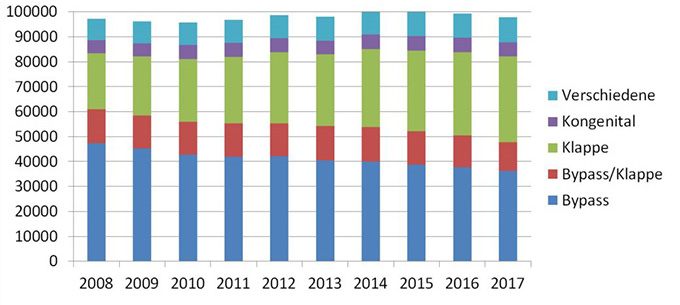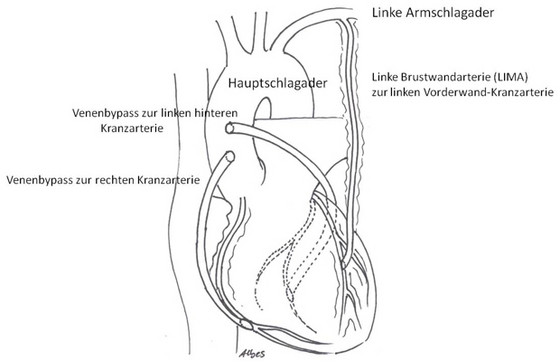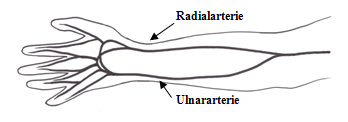
Bypass surgery
Bypass surgery is the most common type of heart surgery. Coronary artery bypass surgery diverts blood around narrowed coronary arteries, re-establishing normal blood supply. This type of surgery usually requires the breastbone (sternum) to be cut in half, but can sometimes by performed using minimally-invasive techniques.
Contact
What is bypass surgery?
Bypass surgery diverts blood around narrowed or blocked coronary arteries by creating a "bypass". This is done to ensure that a sufficient amount of blood and oxygen can reach those parts of the heart muscle that lie beyond the narrowed or blocked section.
The bypass can be created using a section removed from one of the patient's own superficial leg veins (vein graft), or from one of the arteries inside the chest wall (artery graft). Sometimes, a surgeon may use a section of an artery from the lower arm to make a coronary bypass graft.
When is bypass surgery used?
Bypass surgery is used to treat complex and severe forms of coronary heart disease particularly in patients who cannot be treated with medicines or through cardiac catheterization.
In some rare cases, bypass surgery may serve as an emergency measure in the event of an acute heart attack.

How can bypass surgery help?
The purpose of bypass surgery is to relieve blockages that cause reduced blood flow to the heart. A reduction in the flow of blood is commonly associated with a severe build-up of fatty deposits inside one of the coronary arteries. Once the bypass has diverted blood around the blockage, normal blood flow is re-established, with blood once again reaching even those sections of the heart muscle that lie beyond the blockage. In this way, bypass surgery can help to prevent heart failure and heart attacks.
The surgical approach itself generally involves two strategies: a bypass can be created using a vein graft from one of the patient's own veins and, as most people have some healthy superficial vein tissue in their upper or lower legs, this is the most common type of bypass graft used. The removal of the veins does not cause any problems as the remaining blood vessels take over the task of ensuring adequate circulation in the legs. Also, leg veins and coronary arteries are very similar in size.
The other surgical approach consists of a bypass route being created using artery grafts. These are mainly harvested from the left (less frequently, the right) internal thoracic artery. These types of vessels are usually used for bypass routes connecting to the anterior wall. A section of an artery in the lower arm may also be used as a bypass graft.
Although more complex in terms of the procedures involved, artery bypass grafts last considerably longer than vein grafts. As many patients require several bypass grafts to be used as part of one procedure, bypass surgery often involves a combination of both vein and artery grafts.
Most bypass procedures require the breastbone to be cut in half (sternotomy) in order to open the patient's chest. Certain cases, however, may be able to be treated using minimally-invasive techniques , which involve a small incision in the left-hand side of the chest, just below the nipple.
What happens during bypass surgery?
Bypass surgery typically involves the following steps:
- Once the patient has been placed under general anesthesia, the first step is to cut through the breastbone and open the chest.
- The surgeon dissects away the distal end of the left interior thoracic artery from the chest wall. This is used to establish a bypass route to the heart. At the same time, a second surgeon harvests a vein from the leg and, depending on the number of bypass grafts required, this may be cut into several sections.
- The patient is then connected to a pulmonary bypass (heart-lung) machine: after taking in blood from the superior and inferior vena cava, the blood is saturated with oxygen inside the machine and pumped back into the aorta. The machine effectively takes over the function of the heart.
- The heart itself can now be stopped using a special infusion. (In certain cases, this procedure can be performed without the use of a heart-lung machine, with the surgeon working on the beating heart. In these instances, a suction cup is used to minimize the motion of the heart.)
- Using a set of magnifying glasses, the surgeon connects the inner thoracic artery to one of the narrowed coronary arteries, ensuring the connection is situated beyond the narrowed section; the vein grafts previously harvested are then used to establish further bypass routes from the aorta to the coronary arteries.
- When blood is finally allowed to flow through the heart, the heart is warmed up; in many cases, the heart will start to beat spontaneously, or it may be re-started using mild electric shocks.
- Heart function and all bypass connections are carefully checked before the surgical team finally disconnect the heart-lung machine.
- The breastbone is repaired using wire, and the chest is closed.
Different types of bypass surgery
If a cardiologist is unable to use a stent graft to treat a narrowed or blocked section in an artery, the cardiac surgeon will create a new route, or bypass. To do this, the surgeon has a number of different options available:
Bypass surgery using the patient's own vein: CABG (coronary artery bypass grafting)
Due to the fact that most people have some healthy, superficial leg veins that can be used as bypass grafts, CABG is the most common type of bypass.
The process of harvesting leg veins is unproblematic, as continued blood circulation is ensured by the remaining veins. Bypass grafts made from the patient's own leg veins are particularly suitable for bypass surgery, as leg veins and coronary arteries are of a similar size.


Bypass surgery using the internal thoracic artery: LIMA (left internal mammary artery) bypass surgery
In the human body, there are a number of small arteries running along the interior wall of the chest. These happen to be similar in size to the coronary arteries, and are therefore suitable as bypass grafts. This type of vessel is usually used in coronary bypass grafting involving the anterior wall of the heart. Although the process of gaining access to - and forming connections with - these arteries is more challenging in technical terms, this type of graft has good long-term durability.
Bypass surgery using an artery from the lower arm
There are two arteries in the human forearm. The larger of the two, referred to as the radial artery, may be removed as long as the other artery can continue to provide a sufficient amount of blood to the hand. Tests can be used to establish with certainty that this is the case. This will ensure that the removal of the radial artery does not impede blood supply to the hand. The radial artery is similar in size to the coronary arteries, and makes for a highly suitable bypass graft. Although the process of gaining access to - and forming connections with - this type of artery is also rather challenging in technical terms, radial bypass grafts, too, are known to last for a long time.
While the past few years have seen other arteries being harvested from the patient's own body and being used as bypass grafts, these types of grafts have not managed to become established and, nowadays, are used only rarely (e.g. the gastroepiploic artery or the epigastric artery).
The planning of your bypass procedure, as well as the selection of suitable bypass grafts, will be guided by the exact requirements of your particular case, your overall health status and any concomitant disease. This will ensure we can optimize your personal treatment plan by including the most appropriate and up-to-date treatment options.
Technical considerations
OPCAB
Depending on the details of your case, coronary artery bypass surgery may be able to be performed without the use of cardiopulmonary bypass, i.e. without a heart-lung machine (OPCAB: off-pump coronary artery bypass). This procedure is only suitable in cases involving very specific changes to the coronary arteries. Consequently, it is not suitable for use in all patients, nor does its use necessarily constitute a benefit when compared to conventional bypass surgery. As a result, only approximately 14% of all bypass procedures performed in Germany every year involve surgery without the use of cardiopulmonary bypass (heart-lung machine).
MIDCAB
In patients with coronary artery disease affecting only the left coronary artery, bypass grafting can be performed using the left internal mammary artery. This procedure, which is performed without the use of cardiopulmonary bypass (heart-lung machine), involves only a small incision in the chest, below the left nipple (MIDCAB: minimally-invasive direct coronary artery bypass).
MECC
Depending on the details of the case, coronary artery surgery may be possible using a minimally-invasive type of cardiopulmonary bypass, or mini extracorporeal circuit (MECC) cardiopulmonary bypass. This special mini-circuit cardiopulmonary bypass system reduces the adverse effects of cardiopulmonary bypass on blood components. Unfortunately, it is not suitable for use in all patients.
Working in close cooperation with a cardiology specialist, the surgeon selects the most suitable procedure for each individual patient. The surgeon only performs the procedure once this planning process has been completed, including discussions regarding the type of bypass grafts to be used, as well as technical considerations.

